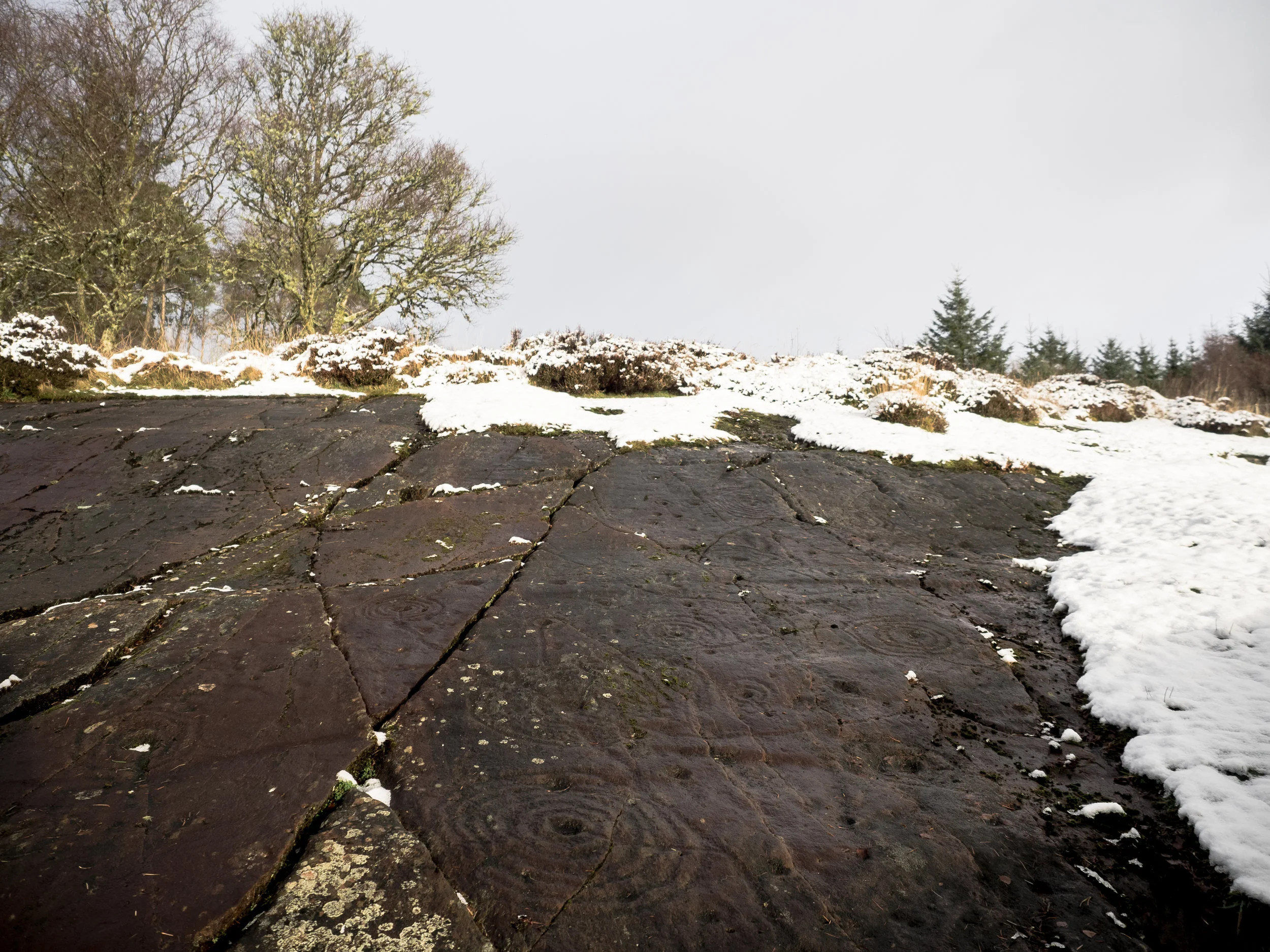Kilmartin Glen
Kilmartin Glen is said to be one of the richest areas of prehistoric remains in Europe. It is only two hours out of Glasgow, but when I mentioned going to this place to nearly anyone in town, they had no idea where we were headed.
We were drawn to the area searching for Andy’s family history, but found an area filled with interesting sites and beautiful scenery – especially when covered in snow in mid December.
Our first stop was to walk through the forest near Cairnbaan, to find the mysterious Achnabreck cup and ring rock carvings. It was snowing as we walked through the forest, and even as we emerged at the carving site; the location of the UK’s most extensive rock carvings, it seems a slightly odd place for such a significant site.
The carvings, as their name suggests are mostly dots encapsulated by various numbers of circles, all carved into the sandstone outcrop in a seemingly nonsensical manner. It is no surprise to me to then learn that these 5000 year old carvings remain a mystery to archeologists.
More complicated carvings such as these are mostly found in low lying areas of Scotland, with simpler ones at higher ground, perhaps indicating the carvings might mean something specific when taken in consideration of their location. Some of the spirals found here seem to mimic ones found of a similar age in Ireland, perhaps suggesting some migration of cultural practices. A popular idea is that these carvings are simply artistic expressions, redrawn as people moved throughout the area. Whatever their purpose, they are fascinating. We opt to cut the walk short and return the fast way to the car as the snow turns to sleet.
Dunnadd is a rocky crag amidst the Mòine Mhòr 'Great Moss' moor near Kilmartin. It was originally occupied as a fort in the Iron Age and later became the seat for the kings of Dal Riata – a Gaelic kingdom that encompassed Argyll in western Scotland and a portion of Northern Island in the late 6th and early 7th century.
These days, Dunadd is a small hill in a boggy moor, but archaeologists believe the moor was once covered by a shallow sea, thereby implying that this small hill was an impenetrable rocky island fortress in Dal Riata’s hey day.
Quickly we climb to the top of the hill and find the carvings in the rock: a faint image of a boar, some inscriptions in the ogham alphabet and most impressively, two human footprints. The footprints are thought to have been used for the inauguration of new kings, signifying their domination of the land all around them. (I have since learnt that these carvings, including the footprint perfectly fitted to my shoe size are actually a convincing fibreglass replica of the invaluable carvings, protected since the 1980’s below their fibreglass copies).
Looking over the moor is particularly special for Andy – we can see the remains of his ancestral family farmhouse ‘Dalnahasaig’ a couple of miles up the moor, by the river.
This is a special place of immense historical importance to Scotland that we were privileged to visit.
We head down the hill and on to Kilmartin to search for relatives in the cemetery and stay at the hotel that night.
In the icy, early morning sun, we head off down the Kilmartin Glen to explore the ‘linear cemetery’ of cairns and standing stones. This walk is more of a stroll for us, taking in the snowy scenes and learning a little history along the way.
Climbing into the various cairns is especially exciting for us. Long since excavated of their bones and treasures, they are now more like concrete bunkers, but the idea that these burial mounds have survived in this glen for perhaps 5000 years is incredible.
The two stones circles at Temple Wood are just as old and as with all stone circles, as mysterious as ever. And, beautiful nonetheless among the modest replanting of the wood.
The Nether Largie standing stones, standing in a field of grazing sheep are not arranged in a circle and their use was hotly debated by archaeologists. Perhaps used to ‘predicted lunar eclipses’, perhaps simply a gateway to the nearby cairns, their evocative post in this ancient landscape is impressive all the same.
An easy walk back along the path by the river takes us back to Kilmartin quickly. This area does not necessarily have all of the charms, bells and whistles of some the more famous ancient sites in Scotland – Orkney in particular comes to mind. However, it is an interesting and beautiful place to visit, one that Historic Scotland and others could more strongly market as a more accessible place to experience the complexities of Scottish ancient history.

















































